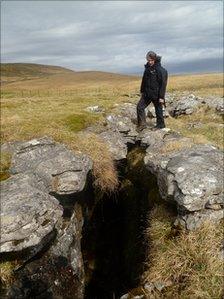Theatre director seeks change of scenery
- Published

Louise Ann Wilson draws parallels between the brain and the landscape
The caves, quarries and clifftops of England's Yorkshire Dales will be the settings for a unique theatrical experience later this month.
Fissure will last three days and lead the audience on a strenuous 12-mile hike up hill, down dale and deep into an intensely personal story created by director and designer Louise Ann Wilson.
Are you fit? Got sturdy, waterproof boots? Warm clothing? Do you mind scrambling over rocky terrain on your hands and feet?
The instruction sheet is pretty clear - Fissure takes place a long way from the nearest comfy theatre seat.
It is the most ambitious project yet for Louise Ann Wilson, who has previously staged acclaimed site-specific theatre productions in Morecambe Bay, woods near Whitby, artisans' cottages in Huddersfield and a department store in Watford.
It is also her most personal, based on her relationship with her sister, who died from a brain tumour a decade ago.
The story follows the course of a tumour, from diagnosis to death, and uses the contours and caverns of the landscape to draw parallels between the brain and the earth.
Fissure begins in the evening of Friday 20 May, when the 150-strong audience arrives at a secret location by train. There they will be met by a dozen singers, musicians and contemporary dancers, who will launch into the production on the platform.
The performers will act out scenes at regular intervals across the next two days and 12 miles - rain or shine - from a "happening" involving pairs of sisters in a quarry, to singing, calling and dancing through a shadowy, echoy "underworld".
It represents the sisters' journey, and the journey of the illness.
As well as the professional performers, the audience will come across visual art installations, a small local choir on a clifftop and the Kirkby Lonsdale handbell ringing group during the main walk on the Saturday.
Wilson has created the artistic adventure with collaborators including poet Elizabeth Burns, Olivier Award-winning composer Jocelyn Pook and choreographer Nigel Stewart.
As well as exploring the potent terrain, the audience will also explore the brain.
Struck by the way doctors spoke of caverns and streamlines inside the skull, Wilson enlisted two neurologists, a geologist and a caver to expand on the scientific similarities by giving talks on site.
"In the way that we've been mapping the landscape, there's been a parallel process about mapping the neurological system," says Wilson.
Wilson stages her shows in unconventional places because they give her a connection to a location and attract people who do not venture into theatres, she says.
And the audience has to get involved. "They have to bring themselves fully to the work," she says.
"There's no switching off and thinking about the shopping list. You have to be fully present."
The title, Fissure, can refer to a crack in a rock, the split between the two hemispheres of the brain and the separation of two people.
Sister's pride
Wilson's sister was diagnosed with a tumour at the age of 24, and died five years later.
"We were very, very close, and still are very close," she says.
"This was 10 years ago now and my sister always really liked the work I'd made. I'd made quite a lot of site specific work and my sister actually wasn't well during a lot of the period when I was making that work, but she came to see most of it and really liked it.
"She just really celebrated that work and she was quite proud of me doing it, I suppose."
Wilson stresses that Fissure is not simply the story of her sister, but that it is one of many layers.
She speaks touchingly about "trying to learn how to be here without her", and it is clear that, on one level, it is a personal reaction to her grief, and an attempt to interpret it through her art.
"Everybody has lost someone they love and the piece, I hope, will be universal," she says.
"There's a very personal starting place which has provided all of these quite complex layers.
"But eventually the piece that people come and experience will, I hope, be universal and will be about, yes, death and grief, but a celebration of life and celebration of place."